
October 15, 2025 — 5:00am
Save
You have reached your maximum number of saved items.
Remove items from your saved list to add more.
Save this article for later
Add articles to your saved list and come back to them anytime.
Got it
“Dozo,” says the elderly woman coming down the trail. It means “after you”, and it’s not surprising you hear it a lot while hiking in Japan, given the locals’ rightful reputation for impeccable manners.
She stops at a steep corner of the narrow, precipitous path leading up to Yakedake, the active volcano that lurks somewhere in the clouds above, rising to 2455 metres.
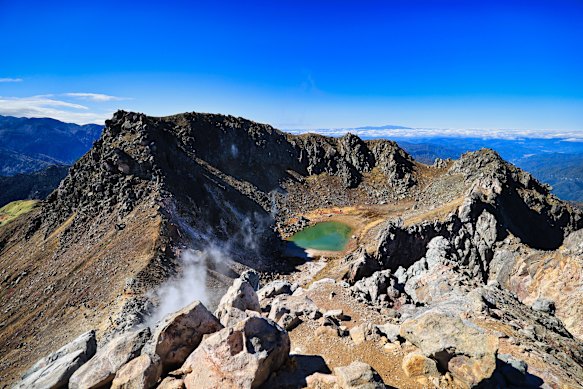 Mount Yakedake in Japan’s northern alps.Getty Images
Mount Yakedake in Japan’s northern alps.Getty Images
“No, no, after you,” replies my wife, Cushla, from the track a few metres below.
“Dozo, dozo,” says the woman. She’s in her 70s, and that’s not surprising, either. Every second group we’ve encountered during our three days of hiking around Kamikochi in Honshu’s Chūbu-Sangaku National Park seems to be made up of retirees.
What does come as a surprise, however, is when the woman slips on the rough scree as she makes room for Cushla to pass. She wobbles like a reluctant bowling pin, and in excruciating slow-motion, topples over the edge and out of sight. Gone.
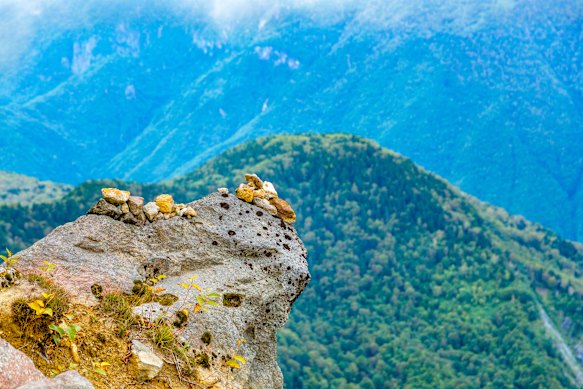 The only way is up.Getty Images
The only way is up.Getty Images
We rush over to help her as best we can, or to at least identify the location of her body for the authorities. Thankfully, the lush vegetation clinging to the steep slope has both cushioned and stalled her fall. Painstakingly, she pulls herself up by plant roots back onto the path, and brushes herself down. Before we have time to conduct the most cursory of welfare checks, she scurries off down the trail, and we’re left thanking the local mountain spirits that she didn’t break her hip, or plunge the 400-odd metres to the valley of Kamikochi below.
Yakedake – literally “burning mountain” – is 250 kilometres west of Tokyo, in Honshu’s Hida mountain range. The closest city is Matsumoto, just over an hour’s drive away. After two days hiking in the Kamikochi valley, we stay at Nakanoyu Onsen Ryokan, which offers a delicious multi-course dinner made from local ingredients, and just happens to sit beside the trail leading up to Yakedake. The onsen’s outdoor pool, surrounded by trees and the stars above, is filled by a volcanic spring, and it whets our appetite for one more climb, to the heat source of that sulphuric hot water.
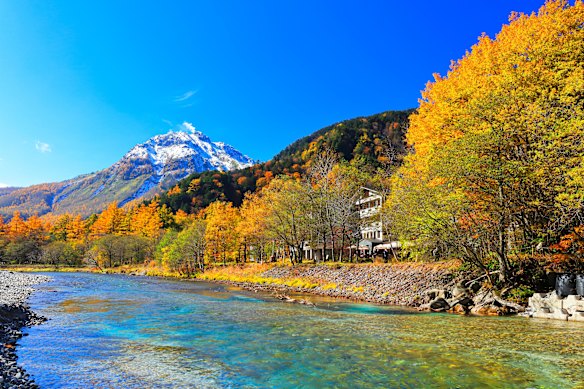 Autumn leaves and snow on Japan’s Mount Yakedake above the Azusa River.Alamy
Autumn leaves and snow on Japan’s Mount Yakedake above the Azusa River.Alamy
And so the next morning, we hike up a rough track, over gnarled tree roots, through towering stands of larch, birch and beech, and past the site of our encounter with the old lady of the mountain, towards the summit of Yakedake. This volcano, which last erupted in 1995, forms the south-western rampart of Kamikochi valley.
Above the treeline, we clamber over a section of boulders marked with painted “O”s to indicate the right path to the summit, and “X”s to mark the wrong.
Mist swirls around Yakedake’s upper reaches, and we wonder if it’s worth the effort – will we get to see anything up top? But we’re so close. Onwards and upwards.
Just as we crest the final ridge, the clouds magically clear. We are greeted by the thrilling sight of the caldera and crater, as nearby sulphur-stained fumaroles vent hot gases from the mountain alive beneath us.
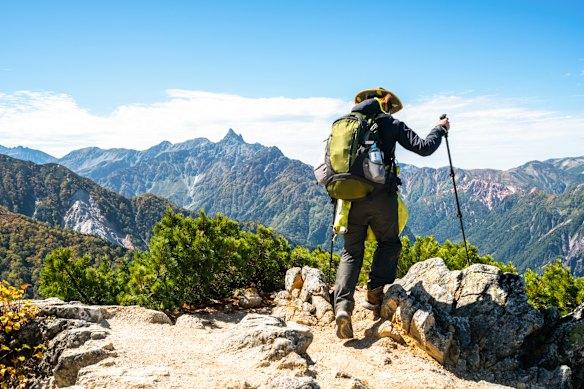 Hiker in Japan’s Northern Alps.iStock
Hiker in Japan’s Northern Alps.iStock
Cushla is cooked. We’ve only hiked for 3.5 kilometres, but we’ve ascended a gruelling 850 metres, and she is happy just to admire the view from the crater ridge.
I decide to continue around a precipitous rocky outcrop and up another 50 metres or so to the top of the north peak. Standing on the 2444-metre summit, drinking in the 360-degree views as the wind whips my shirt and wafts an eggy whiff of volcanic gases, the sensation is pure exhilaration.
Related Article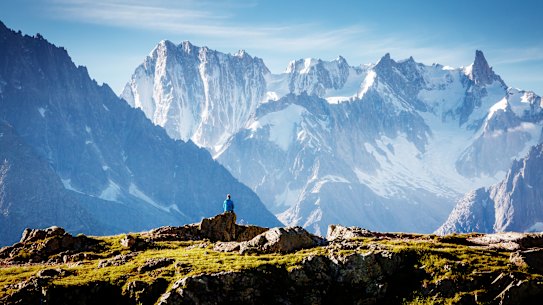
However, with every mighty peak comes a trough, and the three-hour descent back to the trailhead nearly does it for me and my trembling knees. As a revitalised Cushla verily skips down the mountain path, the one thing that keeps me going is the thought of a long soak in a hot onsen.
THE DETAILS
HIKE
The trailhead to Yakedake near Nakanoyu Onsen is most easily accessible by car, which you can hire from nearby Matsumoto. Alternatively, you can reach Yakedake from a hiking trail leading up from Kamikochi valley, which is accessible from Matsumoto via local train and bus.
Yakedake is an active volcano, so check conditions with the Japan Meteorological Agency before you hike.
STAY
Nakanoyu Onsen Ryokan is located a couple of minutes from the trailhead to Yakedake. Rooms from 11,500 yen ($118) a person, including an excellent multi-course dinner and breakfast. There is also a mountain hut, Yakedakegoya, closer to the summit, which offers basic accommodation for 11,500 yen a person, including dinner and breakfast.
Sign up for the Traveller Deals newsletter
Get exclusive travel deals delivered straight to your inbox. Sign up now.
Save
You have reached your maximum number of saved items.
Remove items from your saved list to add more.
![]() Matt Teffer is a journalist and production editor with The Australian Financial Review, and reviews live music for The Sydney Morning Herald.Connect via email.Traveller GuidesFrom our partners
Matt Teffer is a journalist and production editor with The Australian Financial Review, and reviews live music for The Sydney Morning Herald.Connect via email.Traveller GuidesFrom our partners


AloJapan.com